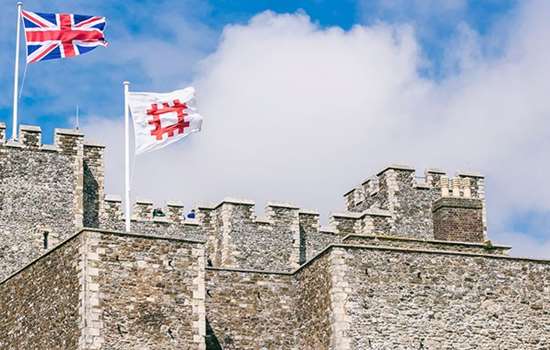13/07/2018
English Heritage builds the ultimate sandcastle
The castle design was based on centuries of real castle-building techniques, many used in the construction of the castles within the care of English Heritage
English Heritage has built the Ultimate Sandcastle at Dover Castle as part of its #LoveCastles summer season. It comes as the charity announces a special sandcastle building weekend at its castles across the country and a competition open to all budding sculptors.
The Ultimate Sandcastle, on display from today, is based on the best techniques from hundreds of years of castle design. It includes strong defensive features such as curtain walls and inner walls, crenellations, a drawbridge, portcullis, gatehouse and a great tower.
Roy Porter, English Heritage Senior Properties Curator and creator of the ultimate sandcastle, said:
'A castle is surely one of the most awe-inspiring sights but if you look closely, all is not what it seems. These amazing structures are a brilliant mix of ages and types, reflecting changing threats and fashions over centuries.
'By studying hundreds of years of trial and error by the real castle builders, our ultimate sandcastle contains everything you'd like to see, with each element showing off castle-building 'perfection' from a different era. I hope people will be inspired to build their very own Ultimate Sandcastle this summer - and support English Heritage to care for all our real castles.
Jamie Wardley, Sand in Your Eye Sand Sculptor, said:
'At Sand in Your Eye we're used to creating great, big sand sculptures all over the world, but this was definitely a once in a lifetime experience. To be able to build and sculpt the most perfect castle, not only from a visual point of view but also historically using Roy's research was a real first for us. Bringing the ultimate sandcastle to life in the grounds of the real, ancient Dover Castle is something we won't easily forget.'
Help defend England's castles
English Heritage looks after 66 castles across England - more than any other organisation in the UK. To preserve these castles, the charity employs some of the country's best castle experts.
In support of the #LoveCastles season, and the Ultimate Sandcastle, the public can get involved by supporting the charity's crowd funder appeal. The appeal will help protect the nation's collection of castles for future generations to enjoy.
Build your own sandcastle
As part of its #LoveCastles summer season, English Heritage is also calling on the public to get involved with its sandcastle workshops.
The workshops will be held on 21 and 22 July at castles including Dover, Carisbrooke, Pendennis, Kenilworth, Bolsover, Framlingham, Scarborough and Warkworth. The workshops are available on a first come, first served basis for a £2 donation to the #LoveCastles appeal.
The public is also invited to celebrate #LoveCastles with a country-wide competition to build a sandcastle this summer. Simply build a sandcastle anywhere in the world, place one of the charity's #LoveCastles flags (available for a £1 donation at staffed sites) on top and share your pictures on Facebook, Twitter or Instagram (@EnglishHeritage) with the hashtag #LoveCastles. Photos can also be uploaded on to the English Heritage website.
Prizes include a stay in a historic holiday cottage amongst a host of other prizes.
Learn how to build the perfect sandcastle on the English Heritage blog.
What makes the ultimate sandcastle?
Need inspiration? Here are some of the key features Roy included in the design for the Ultimate Sandcastle.
Outer Walls: The outer 'curtain' walls around castles provided the first important line of defence for its inhabitants, with the thick stone walls also being reinforced by regularly-placed towers and battlements. Baronial Framlingham Castle in Suffolk was among the first to have these towers, and is also a reminder that some of the strongest castles were raised by noblemen who were frequently at war with the king, or each other.
Inner Bailey or Inner Walls: Should the outer walls and other castle defences be compromised, the inner bailey was a strongly fortified enclosure at the heart of the castle, protecting the Great Tower and the principal accommodation ranged around it. Portchester Castle in Hampshire is a great example of a castle with an existing outer bailey, while royal Dover Castle has both inner and outer towered walls round its Great Tower, making it the mightiest medieval castle in Britain and serving as a chief inspiration for the Ultimate Castle.
Great Tower or Keep: Perhaps most known for their classically 'castle-shaped' structures, keeps were important strongholds reaching their peak of development in the late 1100s. Designed specifically to be the vital last point of defence and also a showy demonstration of wealth and power, they were large stone buildings, often providing comfortable accommodation for their affluent owners. Examples of keeps which inspired the Ultimate Castle include Middleham Castle in North Yorkshire, Richmond Castle in Richmond, Rochester Castle and Dover Castle in Kent, whose keep housed a palace for the great royal castle-builder, King Henry II.
Gatehouse: Effectively serving as the front door to the castle and the main entrance, the gatehouse was one of the most defensive parts of a castle. Positioned to protect the castle's main point of entry, they were fortified buildings, often containing traps, metal portcullises and other methods of keeping the enemy out. But their prominence meant they were also a key point where the wealth and prestige of the castle's owner could be displayed. Taking inspiration from outside the English Heritage collection, Roy used elements of Kent's Tonbridge Castle's impressive gatehouse to design this section of the castle.
Ditch and Bank: A ditch around the circumference of a castle stopped the enemy from directly approaching the outer walls and, while kept at a distance, they could be subject to defensive fire. The defensive aim of a castle was to control and impede access and so the more layers of protection, the more security afforded to the wealthy inhabitants and their household. A great example of this is Helmsley Castle in North Yorkshire which has a wide ditch around its perimeter.
Discover more on our #LoveCastles page.
For more from English Heritage, follow us on Facebook, Twitter and Instagram
More recent news
-

BAUHAUS VISIONARIES HONOURED WITH BLUE PLAQUE
Walter Gropius, Marcel Breuer and László Moholy-Nagy - all designers and teachers at the influential German art school, Bauhaus - have been commemorated with an English Heritage blue plaque.
-

CHILDREN'S MEMORIES OF CASTLES COME FROM TV AND FILM, NOT REAL LIFE
English Heritage has conducted a new survey into generational memories of castles ahead of its #LoveCastles campaign.
-

HELP RICHMOND CASTLE WIN THE 2018 NATIONAL LOTTERY AWARDS
English Heritage's project to conserve the graffiti within Richmond Castle's cell block has been shortlisted for the 2018 National Lottery Awards.